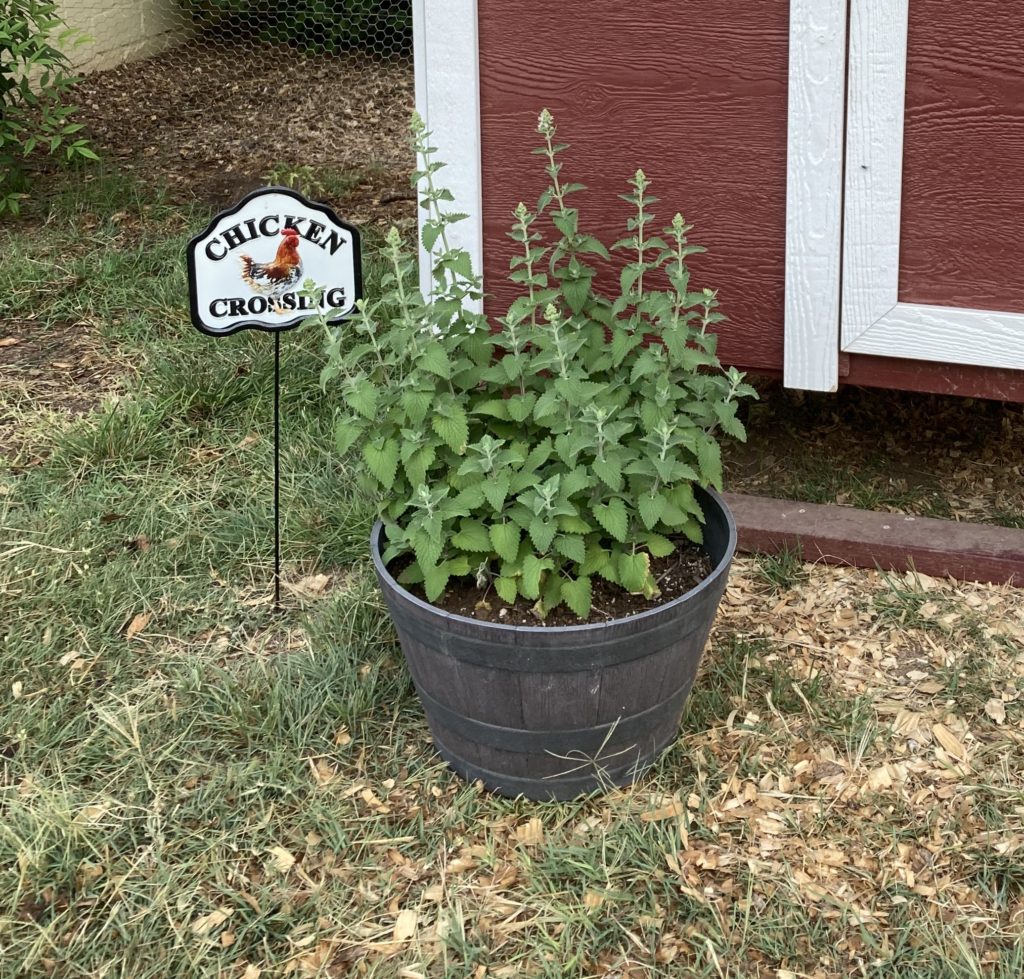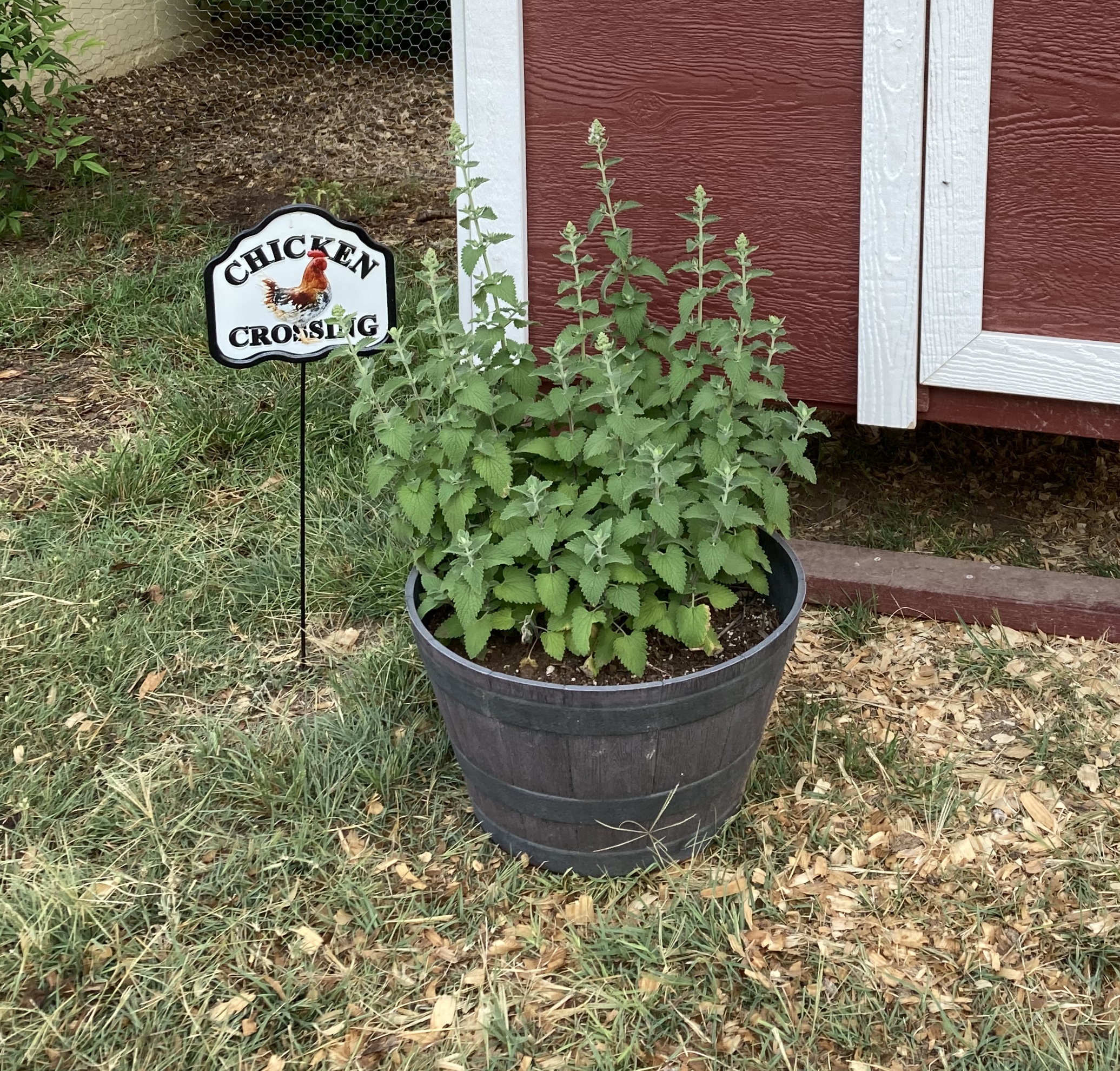Flies are a nuisance that nearly every chicken keeper will need to deal with at some point. Flies can transmit diseases and transfer manure they have walked on to eggs in the nesting boxes. When caring for my chickens, I prefer to use methods that are natural and not use chemicals that can be harmful.
Here are 6 ways to naturally get rid of flies around the chicken coop and run:
- Eliminate standing water or leaking waterers
- Provide plenty of bedding
- Apply diatomaceous earth in coop
- Ensure proper ventilation in coop
- Plant herbs that are insect repellent
- Install fly traps
These methods are part of good coop management and when followed will reduce the fly population in and around your chicken coop.
1. Eliminate Standing Water or Leaking Waterers
Flies are attracted to water and will be located anywhere there is a source of food and water. Fly larvae require water to breed and can often be found in areas that are high in moisture.
To quickly reduce the number of flies around your chicken coop and run, all areas of standing water should be eliminated. Look around your chicken coop and run for any pooling of water from the last time it rained and dump out any empty buckets or planters that contain water.
Make sure your chicken coop and run have adequate drainage and are able to dry out completely within a few days after a large rain. If it takes more than a couple of days for the ground to dry, you might need to consider moving the coop and/or run to a location that has better drainage.
During rainy seasons, especially in warm weather, the flies can quickly take over a coop. As temperatures rise, the reproductive cycle of flies shortens so they are able to reproduce much more quickly.
House flies breed in decaying organic matter such as livestock feces and garbage. They are active on warm days year around but reproduce most quickly in the summer. At 60 °F it takes a house fly about 45 days to go through its life cycle; at 95 °F that time is shortened to 7 days. Adult house flies live for up to three weeks.
Texas A&M AgriLife Extension (“Indoor Flies and Their Control” by Michael Merchant)
Since flies are attracted to stagnant water, the fresh water for your chickens that is changed daily will not be an issue; any eggs or larvae will be rinsed out daily. Do check the waterer for leaks to make sure that water is not dripping into the bedding or ground below the waterer. This wet area can be a perfect breeding ground for flies and other insects.
If flies are a problem in the chicken coop, consider removing the waterer from the coop altogether. Chickens will not wake up in the middle of the night to get water and will only drink when there is light outside. If you are consistent about letting the chickens out in the morning at the first light, there should be no issues by not having water for your chickens in their coop.
2. Provide Plenty of Bedding
Flies are attracted to manure since this is one of their sources of food and also a place for them to lay eggs.
To reduce the fly population around your chickens, you have to manage the manure. This really isn’t as gross as it sounds and is fairly easy.
Start by making sure there is 2 to 3 inches of bedding in your chicken coop. Pine shavings are a great type of bedding, although there are several other options (detailed in this post). In addition to deterring flies, pine shavings will also soak up any odors from the manure.

When you notice there are a several mounds of manure under the roosting bars, add some bedding on top and then toss some scratch grains in the coop and let the chickens scratch around and mix the manure into the new bedding.
Occasionally add more bedding as you see it being tracked out of the coop when the chickens exit. You can also use the pine shavings in the chicken run to soak up any manure in the run as well.
Once the chicken droppings are covered by the bedding and have any liquid parts soaked into the bedding, you should notice a decrease in the number of flies around the chicken coop.
3. Apply Diatomaceous Earth in Coop
Diatomaceous earth (DE) can be applied to the bedding in the chicken as another method of reducing the fly population. When the chickens are out of the coop, sprinkle the DE on the bedding of the coop and let the dust settle before letting the chickens back inside.
The DE will dehydrate any insects that walk across the white powder. This method is best suited for stopping the reproductive cycle of flies since adult flies would need to be dusted with DE in order to be affected. However, their larvae from eggs laid in manure can crawl across areas sprinkled with DE and will die.
I have heard of some people setting up a bucket with chicken droppings and spilled feed and sprinkled with DE. This bucket will then be placed near enough to the chicken coop to attract flies from the coop. Once the flies land on the manure, the DE will do its thing and kill the flies that land on the DE and any larvae from eggs they lay in the bucket.
4. Ensure Proper Ventilation and Turn on Fans
I’ve explained in other posts how ventilation is the most important aspect of a chicken coop. Not only does proper ventilation protect your chickens from respiratory illness, it also helps in deterring flies.
Flies prefer areas that are calm and not breezy. When you have the windows open in the chicken coop and a cross breeze blowing through, flies are less likely to become an issue and will seek out a new location to eat and lay their eggs. (This same concept is applied to businesses that have air curtains at entries to prevent flies and other insects from flying inside the building even though there’s no physical door.)
On days when there is no breeze (or on especially hot days), add a fan to your chicken coop. I have a small fan sitting on an empty planter facing inside the chicken coop from the screen door that blows air through the coop. This initially started out as a way to increase ventilation and cool my chickens during the summer. However, I noticed on days that I didn’t turn on the fan, there would be flies in the coop and nesting boxes.

5. Plant Herbs Around Coop that Are Insect Repellent
There are certain herbs you can plant around your coop that serve as natural insect repellents. Flies have an adverse reaction to these plants’ smells and will avoid areas that have an herbal scent. The great thing about many of these herbs is that chickens enjoy their scent (which can help with laying eggs) and they are safe for your chickens to eat in case they decide to have a snack.
These herbs are natural insect repellants that can be used safely around the chicken coop:
- Lavender. Lavender is the ultimate herb to have in the garden. Not only does it work as a natural insect repellent, its scent is calming to humans and chickens alike. Some people will sprinkle dried lavender in and around nesting boxes to relax hens as they lay eggs. Lavender can be eaten by chickens, although, they are unlikely to eat it fresh from the garden since the scent is strong. If you would like your chickens to eat lavender and gain the benefits of improved digestion and circulatory health, dry the lavender first before mixing it in their feed.
- Mint. Mint comes in several varieties, including spearmint, peppermint, chocolate mint, and orange mint. All of these varieties are natural insect repellents and can safely be used in the chicken coop. Similar to lavender, mint has calming properties so it’s beneficial to place it in the nesting boxes to ease the nerves of laying hens. Mint will spread quickly if planted directly in the ground so either plant in a container or enclosed by a border to prevent it from overtaking your flower bed or yard.
- Lemon balm. Another plant in the mint family is lemon balm. This plant is also easy to grow and has many of the same benefits as other mints. Lemon balm serves as an insect repellent and provides a calming effect on chickens. Some people will take cuttings from their lemon balm plant and toss the sprigs directly into the chicken coop to deter flies and other insects.
- Basil. Basil is another plant in the mint family. Basil is a natural insect repellent and when eaten by chickens can serve as an immune system booster and help improve general overall health of chickens. Similar to lemon balm, chickens are unlikely to eat the basil directly from the garden so you will need to chop it up in fine pieces and add to their feeder.
- Catnip. Catnip is said to deter not only flies but mosquitoes as well. It grows well in either the ground or containers. While there is no harm if your chickens eat catnip, they most likely will not.

Basil 
Catnip
6. Install Fly Traps
The last method of getting rid of flies in the chicken coop are fly traps, and I only suggest these as a last resort. The reason I say these should be a last resort is that the methods described above should take care of any fly situation you have around the chicken coop.
Good coop management practices (like reducing standing water, replacing bedding, and providing adequate ventilation) should take care of most insect problems around the chicken coop. I only include this in the post since some people do use fly traps in their coop and run.
The 2 non-toxic methods of fly traps include:
- Homemade fly solution
- Sticky fly traps
The homemade fly solution is usually made out of a sugary or sweet liquid added to a container that a fly can enter but can’t leave, like a 2-liter bottle with the top cut off and inserted downwards into the bottle. Another method is a dish of water with liquid soap. Once the flies land in the dish, the soap will make their wings heavy and they shouldn’t be able to fly away.
Sticky fly traps can be hung throughout the chicken coop or run. When flies land on the sticky paper, they are not able to free themselves and will become stuck. The problem with the sticky fly traps is that they can come loose and end up on your chickens.
Both of these methods need to be replaced within a few weeks (or days if you have a lot of flies) and can be disgusting to deal with. I don’t like the idea of setting traps that require me to replace them often, are gross to look at, and can cause a mess if they get on my chickens.

Good Coop Management Translates to Less Flies
A tell-tale sign that you have flies in your chicken coop or nesting boxes will be the brown dots on the shells of the fresh eggs. Flies walk on manure as they are eating it or laying their eggs. This manure will be transferred to whatever the flies land on next. This is why it’s so important to take care of flies before they become a much larger problem.
Several weeks ago after a considerable amount of rain, I noticed the fly population around the chicken coop was out of control. There were brown marks on the eggs, on top of the chickens’ feeder, and even on top of the water hose that I use to refill their water. I worked to dry out the chicken run as much as possible. I removed the kiddie pool, poured the water out in the yard, and turned on a fan to help dry the ground in the run. I added another 2 inches of bedding to the coop and replaced the nesting pads that were looking worn. Within a day, the flies were under control and now there’s just a few when you go to the chicken coop (no more than anywhere else in the yard).
By following the methods mentioned above, you should easily be able to get rid of flies in and around your chicken coop and chicken run. These methods are part of good coop managements and are great to employ now to prevent flies from becoming an issue in the future.
An ounce of prevention is worth a pound of cure.
Benjamin Franklin
Reference:
Merchant, Michael. “Indoor Flies and Their Control.” Texas A&M AgriLife Extension. https://agrilifeextension.tamu.edu/library/insects/indoor-flies-and-their-control/. Accessed 14 July 2021.



1 comment
[…] 6 Ways to Naturally Get Rid of Flies Around the Chicken Coop for more ideas on how to reduce the fly population in and around the chicken […]
Comments are closed.